 In addition to circuses, there are a number of circumstances whereby wild animals are used in other types of events or performances which pose the same or similar concerns for animal welfare and ethics, whilst falling outside of the definition of a circus. As such, any legislation introduced to regulate circuses would be unlikely to offer meaningful protection to animals used in similar ways but in different settings. Examples include the presentation of circus-style performances in zoos, presentation of animals at promotional events in nightclubs, hotels, shopping centres or other public places, and in the wider media industry, including television and film.
In addition to circuses, there are a number of circumstances whereby wild animals are used in other types of events or performances which pose the same or similar concerns for animal welfare and ethics, whilst falling outside of the definition of a circus. As such, any legislation introduced to regulate circuses would be unlikely to offer meaningful protection to animals used in similar ways but in different settings. Examples include the presentation of circus-style performances in zoos, presentation of animals at promotional events in nightclubs, hotels, shopping centres or other public places, and in the wider media industry, including television and film.
Regular travelling, unnatural and sometimes cruel training methods, being exposed to strange and potentially frightening surroundings, unnatural social groupings and inappropriate (and sometimes dangerous) interaction with people are some of the welfare issues which animals used in performances in settings other than circuses are exposed to. This is in addition to ethical concerns and negative educational messaging that accompanies these practices.
Circus: An establishment, whether travelling, seasonal or temporary, where wild or domestic animals are kept or introduced that are, or will be wholly or mainly used for the purposes of performing tricks or manoeuvres.
Animal: A multicellular organism of the Kingdom Animalia, including all mammals, birds, reptiles, amphibians, fish, and invertebrates.
Wild Animal: An animal that is not normally or historically domesticated in the specific country.
Domesticated Animal: An animal of a species or breed that has been kept and selectively modified over a significant number of generations in captivity to enhance or eliminate genetic, morphological, physiological or behavioural characteristics, to the extent that such species or breed has become adapted to a life intimately associated with humans.
- EC Regulation which lays down animal health requirements for the movement of circus animals between Member States
- Directive 92/65/EEC which lays down animal health requirements governing trade in animals and their import into the Community
- Directive 91/496/EEC requires veterinary checks of animals entering the Community from third countries
- EU Wildlife Trade Legislation
- In Europe, there are thought to be over 1000 travelling circuses with wild animals
- 15 EU Member States have introduced restrictions on the use of animals in circuses
- Circuses keep many of the same species as zoos, yet are not necessarily required to meet the same standards
- There have been numerous incidences of animals escaping from their enclosures or during street parades, injuring or killing people and damaging property
- Records indicate that there are approximately 113 elephants in circuses, 20 of which are kept on their own
- England has committed to introducing a ban on wild animals in circuses to be implemented on 1st December 2015, whilst Scotland and Wales are currently considering options in this area
- A ban on wild animals in circuses in Austria was subject to legal challenge. The challenge failed and the ban remains in force
- In a poll of Members of the European Parliament (2013), undertaken by Parliament Magazine, MEPs were were broadly in favour of a ban to prevent wild animals performing in circuses (PM Polling 2013)
- Briefing document: Wild animals in EU circucses (2015) ENDCAP
- Are Wild Animals Suited to a Travelling Circus Life? (2009) G Iossa*, CD Soulsbury and S Harris, UFAW
- Circuses with Wild Animals in France (2008) Code Animal French version
- Elephants in Circuses – Analysis of Practice, Policy, and Future (2007) Animal and Society Institute
- Circuses with Wild Animals in the UK (2006) Born Free Foundation
- Keeping of Wild Animals in Circuses (1997) City of Vienna, Austria
- Circuses with Wild Animals in Spain InfoCircos
- Austrian Animal Protection Act, Section 2, Article 27
- Circuses with Wild animals in Latvia Latvia Society for the Protection of Animals



